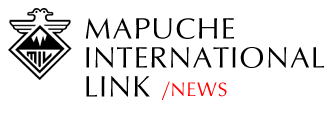



17th February 2013
There is an insurrection raging here in Chile which has not received much attention in the International press. It is not a guerrilla war–there are no heavy arms. The politicians here sometimes call it a “conflict”, at other times they call it “terrorism”. Certainly the government of President Sebastian Piñera now says this is a terrorism especially given recent attacks. This fight is the Mapuche conflict, a struggle between the Chilean people and the Mapuche Indigenous people to reclaim their native lands.
In the South of Chile, in the Araucania or Bio-Bio region, located several hundred miles north of Patagonia, the dry and dusty valleys and barren lower Andes ridges give way to green forests and grasslands as one reaches the area around Temuco. Here rains are frequent. The smell of smoke fills the air as people heat their homes with wood. The ski resorts of Pucon and Villarica, which sits atop an actively smoking volcano, are located just to the south of the disputed area. This placid landscape has seen waves of violence that have surged in recent months while over the long run it has lasted many years.
In the early morning hours of January 4, 2013 20 hooded Mapuche Indians came onto the farm belonging to 75 year old Werner Luchsinger Lemp. The Mapuches set fire to his house burning him and his wife to death alive inside their home.
21 December 2012 two more Mapuches stormed another farm in the same Bio-Bio region of Chile and assassinated the farm’s caretaker Osvaldo Atilio Zapata, 54 years of age.
In April of the same year Mapuche Indians killed a policeman by shooting him through the throat.
In November of last year a group of Mapuche indigenous people felled a tree across the road stopping a tourist bus filled with senior citizens. They told the tourists to get off. Then they set the bus afire. Two trucks which stopped to render assistance were burned as well. Burning vehicles, structure, and forestry equipment is a common tactic of the Mapuche terrorists.
Who exactly are the Mapuche people and why are they attacking the farmers and logging companies in the Araucania region of Chile?
Background
When the British and American frontiersmen settled North America they forced the Cherokees, Iroquois, Apache, Navajo and the other Indian peoples onto reservations where they still live today. But the situation in Latin America is different. The Spanish Conquistadors did not just butcher the Indians and drive them from their homes. Instead as they raped and pillaged, they took the Indian women as wives and mistresses. In Mexico Cortes had his mistress. Her name was Malinche. In Peru Pizarro took the wife of the Incan Indian leader. The result is that European America is made up of people who are white people of the Caucasian race. The people here in Latin America are of mestizo or mixed race whose hair, eye, and skin color varies as one goes from South to North and up and down the social classes.
You can see this written on the face of the people. In Chile, the people on television and the upper class are for the most part of European descent with light skin, light colored hair, and light colored eyes. But the ordinary person here has jet black hair and skin which is somewhat brown but not nearly as dark as the people of Peru, Bolivia, and Mexico.
The Chilean language too is Spanish mixed with a large number of words that come from the Diaguita, Quechua (Inca), Mapudungun (Mapuche), and other Indian languages.
The Inca empire, as most history students know, at one time spread from Ecuador in the North to Chile in the South as the Incas conquered rival Indian nations. But the Incan border stopped abruptly in the Bio-Bio region of Chile. This is where the Mapuche Indian people lived then and still live today.
The Mapuche Indigenous people are a mix of Indian nations which straddles the border between Chile and Argentina. They are comprised of four different Indian peoples who slowly came together to speak the same Mapudungun language.
The Incan armies were able to conquer the northern part of their territory but then were stopped in Bio-Bio in 1493. Then the Incan empire fell back upon itself in civil war. As a weakened nation they were then defeated by the Spanish.
When the victorious Spanish turned their attention to the Mapuche nation in the 16th century they started the War of Araucania which lasted for 300 years. The Mapuche were never defeated. They garroted and tortured the Spanish hero General Pedro de Valdivia instilling fear into the Spanish and increasing the Mapuche reputation as a fierce people who would never be conquered.
When Chile gained its independence from Spain 1810 the Spanish left. Then the Chileans took up the battle and fought the Mapuche until the late 19th century when they conquered the people and put in place a program of pacification. The basic idea of the Chileans was not to carve out a region of Chile and give it to the Mapuches like the Americans did with their Indian reservations. Instead the Chilean government encouraged Europeans to migrate into the area and take the land from the Mapuches one family and one farm at a time. In 1934 Chile government planned to settle 15,000 people into Mapuche areas which they had given to forest companies. The Mapuches fought back and 500 people were killed.
The situation since then has basically been the same with the Mapuches saying that the Chilean government has violated the terms of the treaties and that the military regime further diminished their already disjointed territory by giving land to farmers and forestry companies. The Mapuches are fighting now in terrorist fashion to reclaim the land which was taken from them.
The Government Response
To continue reading this article, please click source: Southern Pacific Review